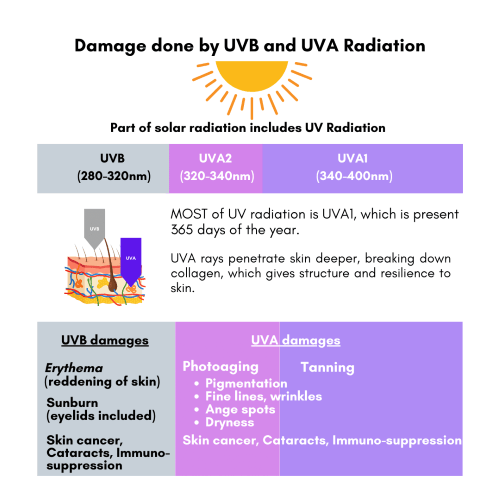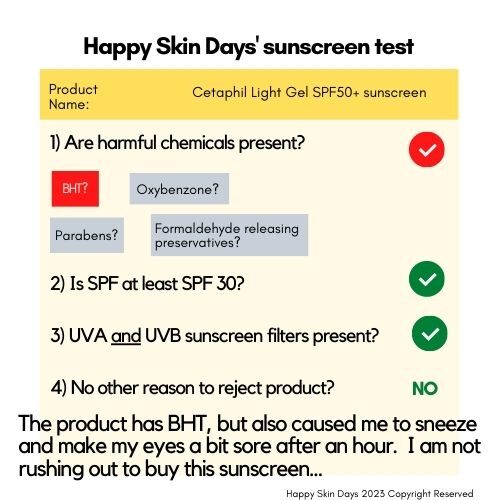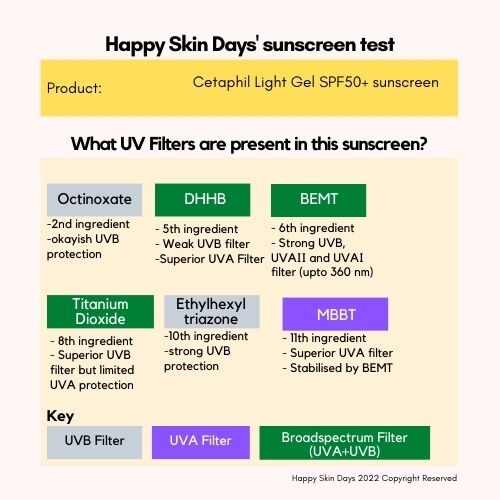Introduction
I bought this sunscreen in India but it has been imported by Galderma and is made and manufactured in France. Immediately, this fills me with confidence because it indicates a certain standard of manufacturing (and yes, b/c its made in the EU and no sunscreen controversies have come out of the EU (yet))
Essentially the product uses multiple filters and I believe there is some synergy in doing so b/c it means you can use less amount of filters. In theory this should make the product easier to spread and use…
Anywho, this is the sunscreen product review
Sunscreen is trying to protect us against which damages?
A brief reminder of how important UVA filters are in a sunscreen, because most damage is done by UVA radiation.

Look and feel of the sunscreen?

Does it blend in quickly?
The sunscreen blends in quickly. Its not quite a gel but has a creamy consistency
Is it heavy on the skin?
Despite the creamy consistency its not heavy on the skin
Does it leave a whitecast?
No
Does it sting the eyes?
Not on application but it did cause my eyes to feel sensitive after an hour.
What does it smell like?
This is a fragranced product and on initial application I can smell the solvent – it smells a bit like alcohol that you use to sanitise surfaces. I was fine for the first hour and then the sunscreen started to cause me to sneeze, which is 101 I am allergic to this.
How did it feel when I reapplied the sunscreen?
Completely fine. I wouldn’t reapply this over make up though.
Happy Skin Days’ sunscreen test
Unfortunately, this doesn’t pass my sunscreen test because I am not a fan of BHT.

It is the policy of this blog to avoid products containing BHT.
David Suzuki’s excellent explanation is, “Limited evidence suggests that high doses of BHT may mimic estrogen, the primary female sex hormone and prevent the expression of male sex hormones, resulting in adverse reproductive affects.”
If you are OK with BHT, then keep reading.
The product is an SPF 50, so more than an SPF 30. Both UVA and UVB sunscreens and filters are present as follows:
UVA and UVB filters present in the sunscreen?
The Filters present and their position in the Ingredient list are discussed below.

Octinoxate or Ethylyhexyl methoxycinnamate is present in an overwhelming number of sunscreens that I have seen, which is no surprise because it’s the most common UVB filter used globally. Octinoxate needs to be present in high % to be effective – its an old school filter.
Its present in the no 2 position here so its providing primary protection against UVB. Other filters providing UVB protection are:
- BEMT (which is photostable and provides superior UVB protection),
- Ethyl hexyl triazone (strong filter) and
- Titanium Dioxide (nano), which honestly looks as if its in the supporting cast. Ordinarily, Titanium Dioxide provides superior UVB protection and lesser UVA protection
UVA protection is primarily being provided by DHHB+MBBT+BEMT.
MBBT also called Biscotrizole. This is a UVA filter that a superior UVA filter, which like DHHB and BEMT is photostable, large in molecular size and provides excellent protection even at low concentrations.
BEMT and DHHB have following features:
- Broadspectrum (so cover UVB and UVA regions)
- BEMT provides superior UVB protection and its UVAI protection starts to taper off at about 360nm
- DHHB provides excellent UVAII and UVAI protection upto 360nm
- Are large molecules, so no dermal penetration
- Photostable, so don’t break down as soon as they come out of a tube.
- Are effective even at low %
Abbreviations used
- Octinoxate: Ethylhexyl methoxycinnamate
- BEMT: Bis-Ethylhexyloxyphenol Methoxyphenyl Triazine
- DHHB: Diethylamino Hydroxybenzoyl Hexyl Benzoate
- MBBT: Methylene Bis-Benzotriazolyl Tetramethylbutylphenol
